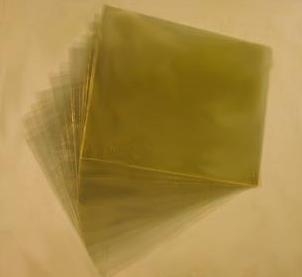ACLAR Film 33C, 7.8 mils thick, 10 x 8
ACLAR 33C Film Dimensions
- Pack of 100 sheets
- Thickness: 7.8 mils (0.0078"/198 µm)
- Lateral Dimensions: 10x8" (254 x 203 mm)
A few not-generally-known words about ACLAR Fluoropolymer Films
There is an entire family of ACLAR Fluoropolymer Films and the different ACLAR "grades" or products, represent different chemistries. The ACLAR film found to be the most ideal for applications in microscopy and histology is ACLAR 33C and it has traditionally been used in 5 mil thickness. This is a polychlorotrifluoroethylene copolymer and this particular composition results in a film with very excellent optical properties, as well as good thermal and chemical stability. It also serves as an excellent moisture barrier. It is always recommended that the user take advantage of a wide range of other information that is known about ACLAR 33C. The high UV transparency of this particular grade of ACLAR makes it idea for use in the UV curing of resins in microscopy and histology.
However, the manufacturer of ACLAR films has discontinued the production of the 5 mil film and only offers the film in 7.8 mils.
Conclusion: If you have been using the 5 mil ACLAR product, and if you were to use the 7.8 mil product, you would see virtually no difference, except for the slightly higher stiffness of the thicker film. The optical properties and UV transparency is essentially the same.
We can summarize some of the most desirable qualities of the ACLAR films.
- Unsurpassed as a clear, flexible moisture barrier
- Crystal clear in optical properties
- Chemically stable and biochemically inert
- Plasticizer and stabilizer free
- Transparent to UV irradiation
- No autofluorescence
- Nonflammable
- Low surface energy and non-aging
- Low dielectric constant and dissipation factor; high dielectric strength
- Stable under the electron beam of an SEM
Some comments specific to use in microscopy and histology laboratories
The fluorinated-chlorinated polymers, because of the fluorinated aspect of the system, exhibit, in some respects almost PTFE-like properties, and therefore separates easily from all of the commonly used epoxy embedding formulations used in microscopy and histology. It can be applied to glass, such as a glass slide, without there being any real evidence for the presence of the film. Cells adhere quite tenaciously to the ACLAR surface, despite the PTFE nature, and they will stay attached through all of the commonly used processing methods such as fixation and dehydration, embedding and even critical point drying.
The film, with attached cells, after critical point drying, can be conventionally sputter coated with gold or other precious metals and for high resolution work in a FESEM, it can be osmium coated or chromium coated. For critical point drying, the 7.8 mil film shows good results.
And finally, the film shows no signs of deterioration even after long term exposure to UV.
ACLAR 33C film can be cut with a fairly ordinary scissors and reportedly, does not damage diamond knives during sectioning.
Resistance to osmium tetroxide:
The ACLAR films do not have the intertness of PTFE, but they are have enough fluorinated character to exhibit far more chemical resistance than a non-fluorinated polyolefin.
One word of caution:
Because of the Cl content in the film, we would urge caution before using ACLAR film in conjunction with any EDS work because of the large count rate that would be coming from the presence of Cl in the film. In general, we would recommend against use of this film when EDS is contemplated, unless of course there were no other alternatives which often times could be the case.

